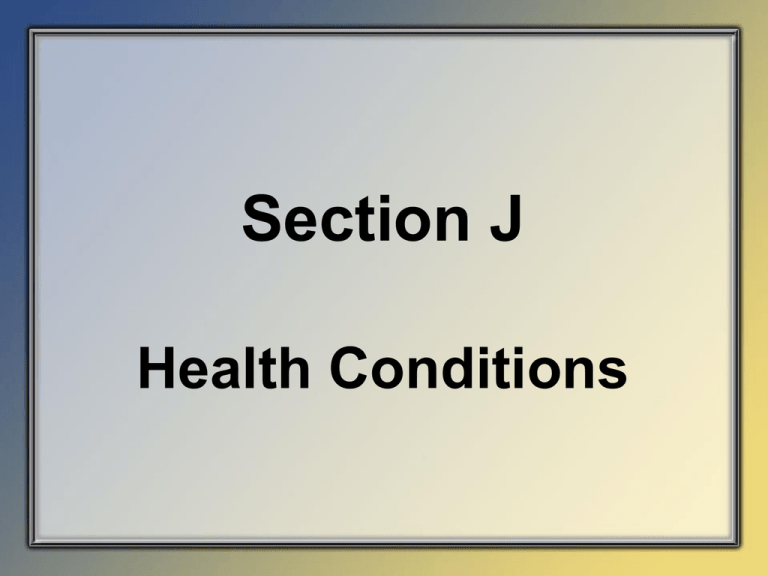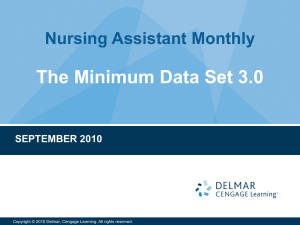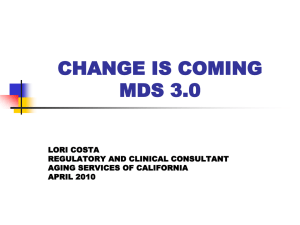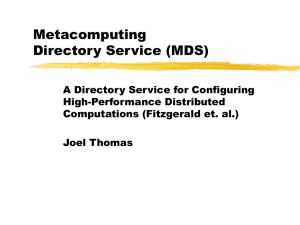Section J Health Conditions
advertisement

Section J Health Conditions Objectives1 • State the intent of Section J Health Conditions. • Identify health conditions assessed in Section J that affect a resident’s functional status and quality of life. • Describe how to conduct the Pain Assessment interview. Minimum Data Set (MDS) 3.0 Section J June 2010 2 Objectives2 • Describe how to conduct the assessment for other health conditions including history of falls, shortness of breath, and tobacco use. • Code Section J correctly and accurately. Minimum Data Set (MDS) 3.0 Section J June 2010 3 Intent of Section J • Document health conditions that impact a resident’s functional status and quality of life: o Pain o Dyspnea o Tobacco use o Prognosis o Problem conditions o Falls Minimum Data Set (MDS) 3.0 Section J June 2010 4 Pain Assessment • Consists of an interview with resident. • Conduct a staff assessment only if resident is unable to participate in the interview. • Pain items assess: o Presence of pain o Frequency of pain o Effect on function o Intensity o Management o Control Minimum Data Set (MDS) 3.0 Section J June 2010 5 Item J0100 Pain Management J0100 Importance • Pain can cause suffering and is associated with: o Inactivity o Social withdrawal o Depressed mood o Functional decline • Pain can interfere with participation in rehabilitation. • Effective pain management interventions can help to avoid these adverse outcomes. Minimum Data Set (MDS) 3.0 Section J June 2010 7 J0100 Conduct the Assessment • Determine what, if any, pain management interventions the resident received during the look-back period. o Review the medical record. o Interview staff and direct caregivers. Minimum Data Set (MDS) 3.0 Section J June 2010 8 J0100 Assessment Guidelines • The look-back period is 5 days. • Include information from all disciplines. • Determine all interventions provided to the resident. • Answer these items even if resident denies pain. Minimum Data Set (MDS) 3.0 Section J June 2010 9 J0100A Scheduled Pain Medication Regimen Coding Instructions • Code 0. No if medical record does not contain documentation that a scheduled pain medication was received. • Code 1. Yes if medical record contains documentation that a scheduled pain medication was received. Minimum Data Set (MDS) 3.0 Section J June 2010 10 J0100B Received PRN Pain Medications Coding Instructions • Code 0. No if record does not contain documentation that a PRN medication was received or offered. • Code 1. Yes if record contains documentation that a PRN medication was either received OR offered but was declined. Minimum Data Set (MDS) 3.0 Section J June 2010 11 J0100C Received Non-Medication Intervention Coding Instructions • Code 0. No if medical record does not contain documentation that a non-medication pain intervention was received. • Code 1. Yes if medical record contains documentation that: o Non-medication pain intervention scheduled as part of the care plan. o Intervention actually received and assessed for efficacy. Minimum Data Set (MDS) 3.0 Section J June 2010 12 J0100 Scenario • The resident’s medical record documents that she received the following pain management in the past 5 days: o Hydrocodone/ acetaminophen 5/ 500 1 tab PO every 6 hours. Discontinued on day 1 of look-back period. o Acetaminophen 500mg PO every 4 hours. Started on day 2 of look-back period. o Cold pack to left shoulder applied by PT BID. PT notes that resident reports significant pain improvement after cold pack applied. Minimum Data Set (MDS) 3.0 Section J June 2010 13 J0100 Scenario Coding1 • Code J0100A as 1. Yes. • The medical record indicated that the resident received a scheduled pain medication during the 5-day look-back period. • Code J0100B as 0. No. • No documentation was found in the medical record that the resident received or was offered and declined any PRN medications during the 5-day look-back period. Minimum Data Set (MDS) 3.0 Section J June 2010 14 J0100 Scenario Coding2 • Code J0100C as 1. Yes. • The medical record indicates that the resident received scheduled non-medication pain intervention (cold pack to the left shoulder) during the 5-day look-back period. Minimum Data Set (MDS) 3.0 Section J June 2010 15 J0100 Pain Management Practice • The resident’s medical record includes the following pain management documentation: o MS-Contin (morphine sulfate controlled-release) 15 mg PO Q 12 hours. • Resident refused every dose of medication during the 5-day look-back period. • No other pain management interventions were documented. Minimum Data Set (MDS) 3.0 Section J June 2010 16 How should J0100A be coded? A. Code 0. No. B. Code 1. Yes. Minimum Data Set (MDS) 3.0 Section J June 2010 17 J0100A Coding • The correct coding is 0. No. • The medical record documented that the resident did not receive scheduled pain medication during the 5-day look-back period. • Residents may refuse scheduled medications. • Medications are not considered “received” if the resident refuses the dose. Minimum Data Set (MDS) 3.0 Section J June 2010 18 How should J0100B be coded? A. Code 0. No. B. Code 1. Yes. Minimum Data Set (MDS) 3.0 Section J June 2010 19 J0100B Coding • The correct coding is 0. No. • The medical record contained no documentation that the resident received or was offered and declined any PRN medications during the 5-day look-back period. Minimum Data Set (MDS) 3.0 Section J June 2010 20 How should J0100C be coded? A. Code 0. No. B. Code 1. Yes. Minimum Data Set (MDS) 3.0 Section J June 2010 21 J0100C Coding • The correct coding is 0. No. • The medical record contains no documentation that the resident received non-medication pain intervention during the 5-day look-back period. Minimum Data Set (MDS) 3.0 Section J June 2010 22 Item J0200 Should Pain Assessment Interview Be Conducted? J0200 Importance • Most residents capable of communicating can answer questions about how they feel. • Obtaining information about pain directly from the resident is more reliable and accurate than observation alone for identifying pain. • Use staff observations for pain behavior only if a resident cannot communicate. o Verbally o With gestures o In writing Minimum Data Set (MDS) 3.0 Section J June 2010 24 J0200 Conduct the Assessment • Determine whether resident is understood at least sometimes. • Review A1100 to determine whether resident needs or wants an interpreter. • Make every effort to have an interpreter present if needed or requested. Minimum Data Set (MDS) 3.0 Section J June 2010 25 J0200 Assessment Guidelines • Skip to J1100 if the resident is comatose. • B0100 is coded 1. Yes. Minimum Data Set (MDS) 3.0 Section J June 2010 26 J0200 Coding Instructions • Code 0. No if resident is rarely/ never understood or an interpreter is required but not available. • Code 1. Yes if resident is at least sometimes understood and an interpreter is present or not required. Minimum Data Set (MDS) 3.0 Section J June 2010 27 Item J0300- J0600 Pain Assessment Interview Importance of Pain Assessment1 • Effects of unrelieved pain impact the individual. o Functional decline o Complications of immobility o Skin breakdown o Infections • Pain significantly adversely affects quality of life. o Depressed mood o Diminished self-confidence and self-esteem o Increase in behavior problems, particularly for cognitively-impaired residents Minimum Data Set (MDS) 3.0 Section J June 2010 29 Importance of Pain Assessment2 • Some older adults limit their activities in order to avoid having pain. • Their report of lower pain frequency may reflect their avoidance of activity more than it reflects adequate pain management. Minimum Data Set (MDS) 3.0 Section J June 2010 30 Pain Assessment Interview • Interview any resident not screened out by J0200. • The interview consists of 4 questions. • Begins with the primary question. o J0300 Pain Presence • Includes 3 follow-up items. o J0400 Pain Frequency o J0500 Pain Effect on Function o J0600 Pain Intensity Minimum Data Set (MDS) 3.0 Section J June 2010 31 Pain Assessment Interview Guidelines1 • The look-back period for all pain interview items is 5 days. • Conduct the interview close to the end of the 5-day look-back period. • Skip to the Staff Assessment if the resident is unable to answer J0300 Pain Presence. • Stop the interview and skip to the Staff Assessment if the resident is unable to answer J0400 Pain Frequency. Minimum Data Set (MDS) 3.0 Section J June 2010 32 Pain Assessment Interview Guidelines2 • Ask each question in order. • Use other terms for “pain” or follow-up discussion if the resident seems unsure or hesitant. • Code 9 if the resident refuses to answer a question and move on to the next question. • If the resident is unsure about whether pain occurred during the look-back period: o Prompt resident to think about the most recent episode. o Try to determine whether it occurred during the lookback period. Minimum Data Set (MDS) 3.0 Section J June 2010 33 Conduct the Interview • • • • • • Establish a conducive environment. Use an interpreter if needed. Make sure the resident can hear you. Explain the reason for the interview. Explain the response choices. Show responses in large font as appropriate. • Allow resident to write responses if needed. Minimum Data Set (MDS) 3.0 Section J June 2010 34 Item J0300 Pain Presence J0300 Pain Presence Conduct the Assessment/ Guidelines • Ask the question as written. • Code for the presence or absence of pain regardless of pain management efforts. • Rates of self-reported pain are higher than observed rates. Minimum Data Set (MDS) 3.0 Section J June 2010 36 J0300 Coding Instructions1 • Code 0. No. o Resident responds “no” to presence of pain. o Even if resident received pain management interventions. o Interview is complete. o Skip to J1100 Shortness of Breath. • Code 1. Yes. o Resident responds “yes” to presence of pain during the look-back period. o Continue with the pain assessment interview. Minimum Data Set (MDS) 3.0 Section J June 2010 37 J0300 Coding Instructions2 • Code 9. Unable to answer. o Is unable to answer. o Does not respond. o Gives a nonsensical response. • Skip to the Staff Assessment for Pain (J0800). Minimum Data Set (MDS) 3.0 Section J June 2010 38 J0300 Scenario • When asked about pain, Mrs. S. responds, “No. I have been taking the pain medication regularly, so fortunately I have had no pain.” Minimum Data Set (MDS) 3.0 Section J June 2010 39 J0300 Scenario Coding • Code J0300 as 0. No. • Mrs. S. reports having no pain during the look-back period. • Even though she received pain management interventions during the look-back period, the item is coded “No” because there was no pain. • Skip to J1100. Shortness of Breath. Minimum Data Set (MDS) 3.0 Section J June 2010 40 J0300 Practice #1 • When asked about pain, Mr. T. responds, “No pain, but I have had a terrible burning sensation all down my leg.” Minimum Data Set (MDS) 3.0 Section J June 2010 41 How should J0300 be coded? A. Code 0. No. B. Code 1. Yes. C. Code 9. Unable to answer. Minimum Data Set (MDS) 3.0 Section J June 2010 42 J0300 Practice #1 Coding • The correct coding is 1. Yes. • Although Mr. T.’s initial response is “no,” the comments indicate that he has experienced pain (burning sensation) during the look-back period. Minimum Data Set (MDS) 3.0 Section J June 2010 43 Item J0400 Pain Frequency J0400 Pain Frequency Conduct the Assessment • Ask the question exactly as written. • May use cue cards to present response options. Minimum Data Set (MDS) 3.0 Section J June 2010 45 J0400 Pain Frequency Assessment Guidelines • Do not offer definitions of response options. • Resident’s response should be based on the resident’s interpretation of the frequency options. • Use echoing to help clarify the preferred option if the resident does not respond according to the response scale. • Stop the interview and skip to J0800 to complete the Staff Assessment for Pain if the resident is unable to respond to this item. Minimum Data Set (MDS) 3.0 Section J June 2010 46 J0400 Coding Instructions • Code the resident’s response. • If the resident has difficulty choosing between two responses: o Use echoing to help resident clarify the response. o Code the more frequent of the two responses. Minimum Data Set (MDS) 3.0 Section J June 2010 47 J0400 Scenario • When asked about pain, Ms. M. responds, “I would say rarely. • Since I started using the patch, I don’t have much pain at all, but four days ago the pain came back. • I think they were a bit overdue in putting on the new patch, so I had some pain for a little while that day.” Minimum Data Set (MDS) 3.0 Section J June 2010 48 J0400 Scenario Coding • Code J0400 as 4. Rarely. • Ms. M. selected the “rarely” response option. Minimum Data Set (MDS) 3.0 Section J June 2010 49 J0400 Practice #1 • When asked about pain, Miss K. responds: o “I can’t remember. I think I had a headache a few times in the past couple of days, but they gave me Tylenol and the headaches went away.” • Interviewer clarifies by echoing what Miss K. said: o “You’ve had a headache a few times in the past couple of days and the headaches went away when you were given Tylenol. o If you had to choose from the answers, would you say you had pain occasionally or rarely?” • Miss K. replies “Occasionally.” Minimum Data Set (MDS) 3.0 Section J June 2010 50 How should J0400 be coded? A. Code 1. Almost constantly B. Code 2. Frequently C. Code 3. Occasionally D. Code 4. Rarely E. Code 9. Unable to answer Minimum Data Set (MDS) 3.0 Section J June 2010 51 J0400 Practice #1 Coding • The correct coding is 3. Occasionally. • After the interviewer clarified the resident’s choice using echoing, the resident selected a response option. Minimum Data Set (MDS) 3.0 Section J June 2010 52 J0400 Practice #2 • When asked about pain, Mr. J. responds: o “I don’t know if it is frequent or occasional. o My knee starts throbbing every time they move me from the bed or the wheelchair.” • The interviewer says: o “Your knee throbs every time they move you. o If you had to choose an answer, would you say that you have pain frequently or occasionally?” • Mr. J. is still unable to choose between frequently and occasionally. Minimum Data Set (MDS) 3.0 Section J June 2010 53 How should J0400 be coded? A. Code 1. Almost constantly B. Code 2. Frequently C. Code 3. Occasionally D. Code 4. Rarely E. Code 9. Unable to answer Minimum Data Set (MDS) 3.0 Section J June 2010 54 J0400 Practice #2 Coding • The correct coding is 2. Frequently. • The interviewer appropriately echoed Mr. J.’s comment and provided related response options to help him clarify which response he preferred. • Mr. J. remained unable to decide between frequently and occasionally. • The interviewer, therefore, coded for the higher frequency of pain. Minimum Data Set (MDS) 3.0 Section J June 2010 55 Item J0500 Pain Effect on Function J0500 Pain Effect on Function Conduct the Assessment • Ask each question as written. Minimum Data Set (MDS) 3.0 Section J June 2010 57 J0500 Pain Effect on Function Assessment Guidelines • Repeat the response and try to narrow the focus of the response if the resident’s response does not clearly indicate “yes” or “no”. o J0500A “Over the past 5 days, has pain made it hard for you to sleep at night?” o Resident responds, “I always have trouble sleeping.” o Try to help clarify the response, “You always have trouble sleeping. Is it your pain that makes it hard for you to sleep?” Minimum Data Set (MDS) 3.0 Section J June 2010 58 J0500 Coding Instructions • Code the resident’s response to each question. Minimum Data Set (MDS) 3.0 Section J June 2010 59 J0500A Scenario • Mrs. D. responds, “I had a little back pain from being in the wheelchair all day, but it felt so much better when I went to bed. I slept like a baby.” Minimum Data Set (MDS) 3.0 Section J June 2010 60 J0500A Scenario Coding • Code J0500A as 0. No. • Mrs. D. reports no sleep problems related to pain. Minimum Data Set (MDS) 3.0 Section J June 2010 61 J0500A Practice #1 • Miss G. responds, “Yes, the back pain makes it hard to sleep. • I have to ask for extra pain medicine, and I still wake up several times during the night because my back hurts so much.” Minimum Data Set (MDS) 3.0 Section J June 2010 62 How should J0500A be coded? A. Code 0. No. B. Code 1. Yes. C. Code 9. Unable to answer. Minimum Data Set (MDS) 3.0 Section J June 2010 63 J0500A Practice #1 Coding • The correct coding is 1. Yes. • The resident reports pain-related sleep problems. Minimum Data Set (MDS) 3.0 Section J June 2010 64 J0500A Practice #2 • Mr. E. responds, “I can’t sleep at all in this place.” • The interviewer clarifies by saying, o “You can’t sleep here. o Would you say that was because pain made it hard for you to sleep at night?” • Mr. E. responds, o “No. It has nothing to do with me. I have no pain. o It is because everyone is making so much noise.” Minimum Data Set (MDS) 3.0 Section J June 2010 65 How should J0500A be coded? A. Code 0. No. B. Code 1. Yes. C. Code 9. Unable to answer. Minimum Data Set (MDS) 3.0 Section J June 2010 66 J0500A Practice #2 Coding • The correct coding is 0. No. • Mr. E. reports that his sleep problems are not related to pain. Minimum Data Set (MDS) 3.0 Section J June 2010 67 J0500B Scenario • Mrs. N. responds, “Yes, I haven’t been able to play the piano, because my shoulder hurts.” Minimum Data Set (MDS) 3.0 Section J June 2010 68 J0500B Scenario Coding • Code J0500B as 1. Yes. • Mrs. N. reports limiting her activities because of pain. Minimum Data Set (MDS) 3.0 Section J June 2010 69 J0500B Practice #1 • Ms. L. responds, “No, I had some pain on Wednesday, but I didn’t want to miss the shopping trip, so I went.” Minimum Data Set (MDS) 3.0 Section J June 2010 70 How should J0500B be coded? A. Code 0. No. B. Code 1. Yes. C. Code 9. Unable to answer. Minimum Data Set (MDS) 3.0 Section J June 2010 71 J0500B Practice #1 Coding • The correct coding is 0. No. • Although Ms. L. reports pain, she did not limit her activity because of it. Minimum Data Set (MDS) 3.0 Section J June 2010 72 J0500B Practice #2 • Mrs. S. responds, “I don’t know. • I have not tried to knit since my finger swelled up yesterday, because I am afraid it might hurt even more than it does now.” Minimum Data Set (MDS) 3.0 Section J June 2010 73 How should J0500B be coded? A. Code 0. No. B. Code 1. Yes. C. Code 9. Unable to answer. Minimum Data Set (MDS) 3.0 Section J June 2010 74 J0500B Practice #2 Coding • The correct coding is 1. Yes. • Mrs. S. avoided a usual activity because of fear that her pain would increase. Minimum Data Set (MDS) 3.0 Section J June 2010 75 Item J0600 Pain Intensity J0600 Pain Intensity • Numeric Rating Scale (scale of 00 to 10) • Verbal Descriptor Scale • Complete only one of these items, not both. Minimum Data Set (MDS) 3.0 Section J June 2010 77 J0600 Conduct the Assessment • Read the question and response options slowly. • Ask the resident to rate his or her worst pain. o “Please rate your worst pain over the last 5 days with zero being no pain, and ten as the worst pain you can imagine.” o “Please rate the intensity of your worst pain over the last 5 days.” • Use cue cards to show response options if needed. Minimum Data Set (MDS) 3.0 Section J June 2010 78 J0600 Assessment Guidelines • The look-back period is 5 days. • Try to use the same scale used on prior assessments. • If a resident is unable to answer using one scale, try the other scale. • The resident may answer three ways: o Verbally o In writing o Both Minimum Data Set (MDS) 3.0 Section J June 2010 79 J0600A Numeric Rating Scale Coding Instructions • Code as a two-digit value. o Use a leading zero for values less than 10. o Enter 99 if unable to answer or does not answer. • Leave the response for J0600B blank. Minimum Data Set (MDS) 3.0 Section J June 2010 80 J0600B Verbal Descriptor Scale Coding Instructions • Code as a one-digit value. • Enter 9 if unable to answer or does not answer. • Leave the response for J0600A blank. Minimum Data Set (MDS) 3.0 Section J June 2010 81 J0600 Scenario #1 • The nurse asks Ms. T. to rate her pain on a scale of 0 to 10. • Ms. T. states that she is not sure, because she has shoulder pain and knee pain, and sometimes it is really bad, and sometimes it is OK. • The nurse reminds Ms. T. to think about all the pain she had during the last 5 days and select the number that describes her worst pain. • She reports that her pain is a “6.” Minimum Data Set (MDS) 3.0 Section J June 2010 82 J0600 Scenario #1 Coding • Code J0600A as 06. • The resident said her pain was 6 on the 0 to 10 scale. Minimum Data Set (MDS) 3.0 Section J June 2010 83 J0600 Scenario #2 • The nurse asks Mr. R. to rate his pain using the verbal descriptor scale. • He looks at the response options presented using a cue card and says his pain is “severe” sometimes, but most of the time it is “mild.” Minimum Data Set (MDS) 3.0 Section J June 2010 84 J0600 Scenario #2 Coding • Code J0600B as 3. Severe. • The resident said his worst pain was “Severe.” Minimum Data Set (MDS) 3.0 Section J June 2010 85 Section J Pain Assessment Interview Activity Activity Instructions • Turn to Section J items J0300 - J0600 in the MDS 3.0 instrument. • Watch the Pain Interview video. • Code the interview in the MDS 3.0. Minimum Data Set (MDS) 3.0 Section J June 2010 87 Pain Assessment Interview Video The Video on Interviewing Vulnerable Elders (VIVE) was funded by the Picker Institute and produced by the UCLA/JH Borun Center. DVD copies can be ordered from the Pioneer Network. Minimum Data Set (MDS) 3.0 Section J June 2010 88 Pain Assessment Interview Coding • J0300 1. Yes • J0400 1 Almost constantly • J0500A (sleep) 1. Yes • J0500B (activities) 1. Yes • J0600A Numeric Rating Scale code 08 Minimum Data Set (MDS) 3.0 Section J June 2010 89 Item J0700 Should the Staff Assessment for Pain Be Conducted J0700 Importance • Resident interview for pain is preferred because it improves the detection of pain. • A small percentage of residents is unable or unwilling to complete the pain interview. • Persons unable to complete the pain interview may still have pain. Minimum Data Set (MDS) 3.0 Section J June 2010 91 J0700 Conduct the Assessment • Review the resident’s responses to J0200 - J0400. • Determine if the pain assessment interview was completed. o J0300 Presence of Pain coded 0. No. OR o J0300 Presence of Pain coded 1. Yes. o J0400 Pain Frequency is answered. Minimum Data Set (MDS) 3.0 Section J June 2010 92 J0700 Coding Instructions • Code 0. No. o Resident completed the Pain Assessment Interview. o Skip to J1100 Shortness of Breath (dyspnea). • Code 1. Yes. o Resident unable to complete the Pain Assessment Interview. o Continue to J0800 Indicators of Pain or Possible Pain. Minimum Data Set (MDS) 3.0 Section J June 2010 93 Items J0800 & J0850 Staff Assessment for Pain J0800/ J0850 Importance1 • Residents who cannot verbally communicate about their pain are at particularly high risk for underdetection and undertreatment of pain. • Severe cognitive impairment may affect ability of residents to communicate verbally. o Limits availability of self-reported information about pain. o Fewer complaints may not mean less pain. • Individuals unable to communicate verbally may be more likely to use alternative methods of expression to communicate pain. Minimum Data Set (MDS) 3.0 Section J June 2010 95 J0800/ J0850 Importance2 • Some verbal complaints of pain may be made and should be taken seriously. • Unrelieved pain adversely affects function and mobility, contributing to: o Dependence o Contractures o Skin breakdown o Weight loss • Pain significantly adversely affects quality of life and is tightly linked to depressed mood, diminished selfconfidence and self-esteem, as well as to an increase in behavior problems. Minimum Data Set (MDS) 3.0 Section J June 2010 96 Indicators of Pain1 • Non-Verbal Sounds include but not limited to: o Crying o Moaning o Whining o Groaning o Gasping o Other audible indications • Vocal Complaints of Pain include but not limited to: o “That hurts.” o “Ouch.” o “Stop.” Minimum Data Set (MDS) 3.0 Section J June 2010 97 Indicators of Pain2 • Facial Expressions include but not limited to: o Grimaces o Furrowed brow o Winces o Clenched teeth or jaw o Wrinkled forehead • Protective Body Movements or Gestures include but not limited to: o Bracing o Guarding o Rubbing/ massaging a body part Minimum Data Set (MDS) 3.0 o Clutching/ holding a body part during movement Section J June 2010 98 J0800 Conduct the Assessment • Review the medical record. o Look for documentation of indicators of pain. o Confirm presence of indicators of pain with direct care staff on all shifts who work with resident during ADLs. • Interview staff. o Question staff who observe or assist the resident. o Ask about presence of each indicator not in the record. • Observe the resident. Minimum Data Set (MDS) 3.0 Section J June 2010 99 J0800 Assessment Guidelines • The look-back period is 5 days. • Some symptoms may be related to pain: o Behavior change o Depressed mood o Rejection of care o Decreased participation in activities • Do not report these symptoms here as pain screening items. Minimum Data Set (MDS) 3.0 Section J June 2010 100 J0800 Coding Instructions • Check all indicators of pain that apply. • Based on staff observation of indicators of pain. • Check Z if no indicators of pain are observed. Minimum Data Set (MDS) 3.0 Section J June 2010 101 J0800 Scenario • Mr. P. has advanced dementia and is unable to verbally communicate. • A note in his medical record documents that he has been awake during the last night crying and rubbing his elbow. • When you go to his room to interview the certified nurse aide (CNA) caring for him, you observe Mr. P. grimacing and clenching his teeth. • The CNA reports that he has been moaning and said “ouch” when she tried to move his arm. Minimum Data Set (MDS) 3.0 Section J June 2010 102 J0800 Scenario Coding • Mr. P. has demonstrated: o o o o Non-verbal sounds (crying and moaning) Vocal complaints of pain (“ouch”) Facial expression of pain (grimacing and clenched teeth) Protective body movements (rubbing his elbow) Minimum Data Set (MDS) 3.0 Section J June 2010 103 J0850 Frequency of Pain Indicators • Assessment of pain frequency provides: o Basis for evaluating treatment need and response to treatment o Information to aide in identifying optimum timing of treatment • Interview staff and direct caregivers. • Determine number of days the resident either complained of pain or showed evidence of pain during the look-back period. • The look-back period is 5 days. Minimum Data Set (MDS) 3.0 Section J June 2010 104 J0850 Coding Instructions • Code 1 if indicators observed 1-2 days. • Code 2 if indicators observed 3-4 days. • Code 3 if indicators observed daily. • Do not code the number of times that indicators of pain were observed or documented. Minimum Data Set (MDS) 3.0 Section J June 2010 105 J0850 Scenario • Mr. M. is an 80-year old male with advanced dementia. • Mr. M. was noted to be grimacing and verbalizing “ouch” over the past 2 days when his right shoulder was moved during the 5-day look-back period. Minimum Data Set (MDS) 3.0 Section J June 2010 106 J0850 Scenario Coding • Code J0850 as 1. Indicators of pain or possible pain observed 1 – 2 days. • He has demonstrated vocal complaints of pain (“ouch”) and facial expression of pain (grimacing) on 2 of the last 5 days. Minimum Data Set (MDS) 3.0 Section J June 2010 107 Section J Summary Pain Assessment • Complete a pain assessment interview if at all possible. • When determining the assessment for pain intensity, use either the Verbal Descriptor Scale or the Numeric Rating Scale, not both. • Complete the staff assessment for pain only if an interview cannot be completed. • Complete a pain assessment even if the resident denies pain. Minimum Data Set (MDS) 3.0 Section J June 2010 109





